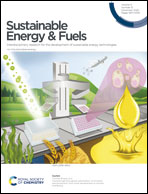Clean and effective utilization of moldy peel as a biomass waste resource in the gasification process of petroleum coke
Abstract
We conducted an exploratory study on the characteristics and applications of carbonaceous materials prepared using different types of biomass and petroleum coke (PC). The strengthening mechanism was analyzed based on the outcomes of the experimental results we obtained from micro-analytical methods, such as Fourier-transform infrared spectroscopy, Raman spectroscopy and scanning electron microscopy. The results indicated that within the scope of the experiment, when mixed with petroleum coke, moldy orange peel (M-OP) played a prominent strengthening role. The strengthening manifests itself as a 30–70 °C reduction in Tmax. Notably, the reaction rate at Tmax and the activation energy were markedly reduced as the biomass ratio increased from 20% to 50%. The increase in activity may also be related to the fermentation of OP. Microorganisms produce enzymes, causing the enzymatic hydrolysis of the fibrous part of OP to produce a large number of small molecules, increase the specific surface area, and expose more carboxyl, hydroxyl and other active groups. This study may provide new insights into expanding the application of biomass and have important implications for developing different types of biomass as carbon materials in production systems to promote clean, efficient production.



 Please wait while we load your content...
Please wait while we load your content...